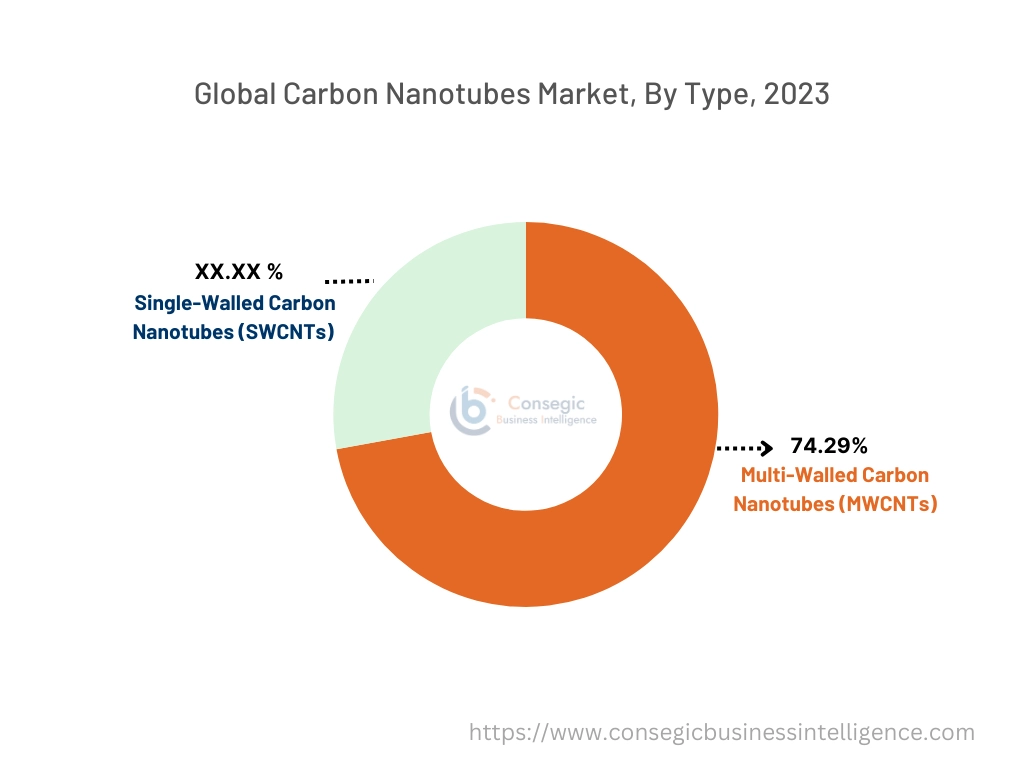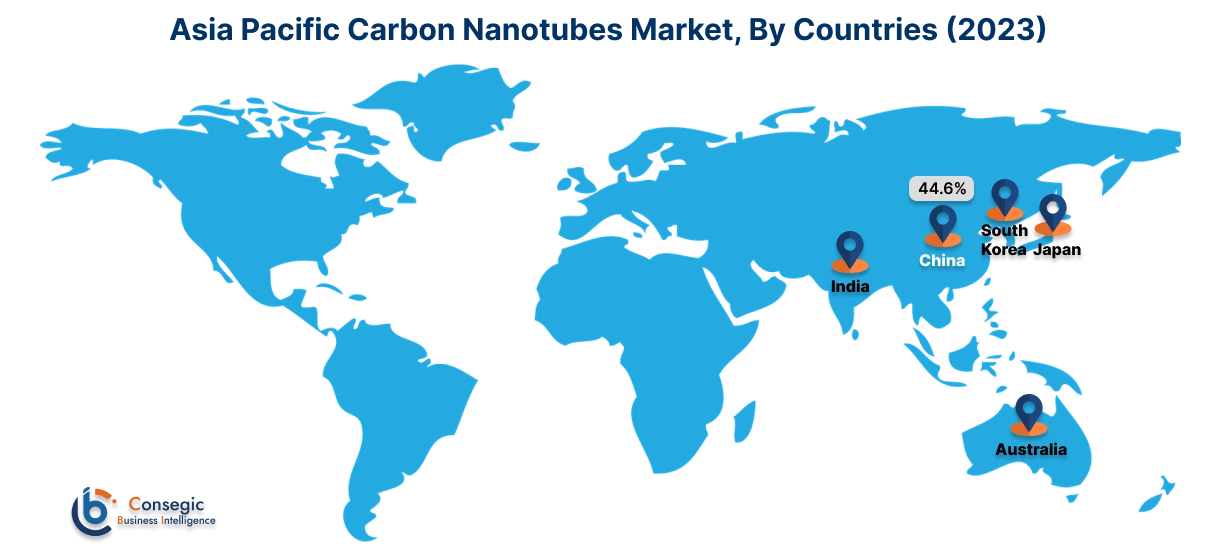- Summary
- Table Of Content
- Methodology
Carbon Nanotubes Market Size:
Carbon Nanotubes Market size is estimated to reach over USD 13.85 Billion by 2031 from a value of USD 4.39 Billion in 2023 and is projected to grow by USD 4.99 Billion in 2024, growing at a CAGR of 15.4% from 2024 to 2031.
Carbon Nanotubes Market Scope & Overview:
Carbon nanotubes (CNTs) are spherical molecules that are made up of graphene atoms (single-layer carbon atoms) folded into sheets. They are grouped under the structural family of fullerenes. There are different types of CNTs and based on length they vary from few micrometers to centimeters. They have nanoscale widths, ranging from 1 to 50 nanometers. CNTs are of two primary types, single-walled CNT (SWCNT) and multi-walled CNT (MWCNT). Their properties range from high elasticity to high strength. CNTs also have a high aspect ratio to high surface area and exceptional thermal, chemical, and electrical conductivity, etc. These unique properties of CNTs render them beneficial for enhancing the properties of other materials, improving energy storage capacity, and balancing environmental sustainability. CNT's usage can be found in various industries such as biomedical and energy sectors, aerospace and architecture industry, electronics and semiconductor industry, etc.
Carbon Nanotubes Market Insights:
Key Drivers:
Growing Demand in Electronics and Semiconductors Expands the Carbon Nanotubes Market
CNTs allow a seamless flow of electrons and offer little to no resistance. This exceptional electrical property makes CNTs desirable in the electronics sector for building components such as conductive films, transistors, etc. Unlike silicon-based transistors, CNTs are compact, fast, and extremely energy-efficient. It makes CNTs a crucial component for the production of cutting-edge electronics. Not only electronics but also the semiconductor industry finds CNTs important, as conventional copper interconnects pose electromigration and high-electrical resistance. CNTs rectify the challenge faced by copper interconnects with their excellent high-conductivity properties by improving the functioning of microchips.
- In a recent discovery by researchers at Peking University (China), a new tensor processing unit (TPU) which is based on CNTs is developed. This new microchip could run artificial intelligence (AI) codes more expertly and energy-efficiently.
Therefore, as the need for better and more micro-minimized electronics and semiconductors grows, there is carbon nanotubes market expansion.
Key Restraints :
High Production Costs Hinders Market Growth
CNTs require significant primary investment during the setup of facilities for their production. This initial expense is unavoidable as the synthesis method necessitates the usage of raw materials such as hydrocarbons or graphite. These raw materials are then processed through methods like CVD or laser ablation. The entire production process needs specialized equipment as high temperatures are required. Even after going through the entire process, the scalability factor of CNTs is challenging. This is because maintaining uniformity and quality while producing industrial-scale levels ends up being expensive. There is also the challenge of low yields that CNT production faces. This signifies that at certain times, raw materials are not converted into CNTs that can be used resulting in higher per-unit production costs.
Thus, as per the analysis, high production costs make CNTs prices high, which limits its adoption in cost-sensitive industries.
Future Opportunities :
Energy Storage and Conversion Offer Opportunity for Carbon Nanotubes Market Growth
The excellent electrical conductivity of CNTs makes them ideal for usage in supercapacitors as well as batteries. For example, in batteries, they are used as conductive additives in electrodes to improve electron mobility. This helps in the improvement of the battery's overall performance. CNTs are also known to have high porosity making them effective for energy storage.
- In June 2023, CHASM Advanced Materials Inc. announced the launching of NTeC®-E. It is a conductive CNT additive for lithium batteries and is used in electric vehicles (EVs). Unlike traditional carbon nanotube additives, the integration of CNT results in lower electrical resistance due to its high electric permeability.
Therefore, as energy storage capacity and conversion experience expansion, they are increasingly giving carbon nanotubes market opportunity to grow.
Carbon Nanotubes Market Segmental Analysis :
By Type:
The market is bifurcated based on types into Single-Walled Carbon Nanotubes (SWCNTs) and Multi-Walled Carbon Nanotubes (MWCNTs).
Trends in the type:
- A rising trend in this market is focused on making CNTs more soluble and compatible with different matrices.
- Recent research has opened up new opportunities for CNT in cancer therapies as well as use in plant biotechnology.
Multi-walled carbon nanotubes (MWCNTs) accounted for the largest revenue share of 74.29% in the carbon nanotubes market in 2023.
- The production costs of multi-walled CNTs are comparatively less expensive since their synthesizing process is simpler and can be scaled up with ease.
- MWCNTs have varied applications, due to their multiple concentric layers. This makes them ideal for structural composites, conductive polymers, etc.
- These types of CNTs have been in this market for a long time and have a more refined synthesizing process. This renders MWSCNTs with a higher adoption rate in industries such as energy storage.
- For instance, a 2023 journal, ‘Sensors & Diagnostics' talks about how bioengineered MWCNTs biosensors can detect analytes in food, monitor the environment, and can also help in clinical diagnosis.
- Therefore, as per the analysis, MWCNTs minimal complexity makes it the largest revenue-gathering segment in the carbon nanotubes market growth.
Single-walled carbon nanotubes (SWCNTs) are expected to have the fastest-growing CAGR in the carbon nanotubes market during the forecasted period.
- Single-walled CNTs have excellent material properties, like high electrical conductivity and tensile strength because of their single-layer structure.
- SWCNTs are suitable for employment in high-tech avenues due to their superior thermal, electrical, and chemical conductivity.
- These types of CNTs are compatible with biomedical lines as their rarefied properties allow them to have accurate drug delivery systems.
- For instance, a professor from Meijo University developed a new way to synthesize high-quality SWCNTs using cobalt (Co) and iridium (Ir) as nanoparticle catalysts. This could scale up SWCNTs for industrial purposes.
- Thus, as per the carbon nanotubes market analysis, SWCNTs offer user-friendly solutions, such as diminishing less sustainable materials and replacing heavy metals, they are set to have fast progression in the future.

By Method of Synthesis:
The market is segmented based on the method of synthesis into Chemical Vapor Deposition (CVD), Arc Discharge, and Laser Ablation.
Trends in the Method of Synthesis:
- A recent and unique CNT synthesis method is to use biomass waste that can help solve the environmental concerns regarding biomass accumulation and purify water.
- CNTs synthesized through the CVD method can be utilized for next-generation IoT, wearable electronic devices, TSVs, interconnects, etc.
Chemical vapor deposition (CVD) accounted for the largest revenue share in the carbon nanotubes market in 2023.
- Chemical vapor deposition is a cost-effective and scalable way of synthesizing CNTs, making it ideal for adoption in industrial applications where CNT is required in large numbers.
- CVD offers high purity and very minimal structural defects, making it ideal for electronics or energy storage systems.
- This synthesis method can produce varied types of CNT, be it single-walled or multi-walled.
- Thus, as per analysis, the CVD offers precise control over the customization of CNTs, making it the largest revenue-generating segment in this market.
Laser Ablation is expected to have the fastest-growing CAGR in the carbon nanotubes market during the forecasted period.
- Laser ablation allows the manufacturing of high-quality single-walled CNTs with fewer defects and increased purity.
- The nanotubes produced through this method are in high demand in optoelectronics as they have a uniform structure.
- This method is also used in research and development as it can produce high-purity CNTs in limited quantities.
- For instance, near-infrared (NIR) can purify, alter the structure, and ablate carbon nanotubes. This is because CNTs are promising photothermal materials with wide optical absorbance and stability. A low-crystalline and vertically aligned CNT is produced as a result.
- Therefore, as per the analysis laser ablation is poised to have the fastest growth in the future owing to its capability of producing high-performance CNTs for various industries.
By Application:
The market is segmented based on its applications into chemical & polymers, energy storage, structural composites, medical, and others.
Trends in the Application:
- CNTs can be used to produce high-quality sporting goods, like rackets, tennis balls, etc.
- As per trend based on growing consciousness about the environment, CNTs are also used for environmental remediation as they produce fewer carbon footprints.
Structural Composites accounted for the largest revenue share in the carbon nanotubes market in 2023.
- The mechanical properties of CNTs make them highly tensile, flexible, and durable. When such properties are integrated with composite materials, CNTs make composites suitable for structural applications.
- CNT-infused structural composites are important in the aerospace sector as well as the automotive sector. This is primarily because lightweight yet sturdy materials are required in these industries to achieve e-fuel efficiency.
- They are used in the manufacturing of construction components like beams, columns, etc because CNT-infused structural composites are corrosion-resistant and have longevity.
- For instance, NASA has been focusing its research on developing an extremely lightweight material that can used instead of metal or fiber composites. The project, Super Lightweight Aerospace Composites (SAC) aimed to scale up the manufacturing of CNT-imposed composites in aerospace structures.
- Thus, structural composites' versatile nature and adaptability made them the largest revenue-generating carbon nanotubes market share.
Energy Storage is expected to have the fastest-growing CAGR in the carbon nanotubes market during the forecasted period.
- CNT is used in lithium-ion batteries which are then used in electric vehicles (EVs) to enhance capacity and reduce charging duration, making them efficient and sustainable.
- CNTs are lightweight but have high strength, making them suitable for portable electronics and wearable devices.
- Advancements made in nanotech have resulted in the enhancement of the structural properties of CNTs. Such improvements like solid-state batteries are propelling the adoption of CNTs in the energy storage sector.
- Therefore, as CNTs are more suitable for a wide range of activities, their adoption in energy storage systems would make this the fastest-growing sector in the future.
By End-User:
The market is segmented based on end-users into Automotive, Aerospace, Electronics, Energy, Healthcare, and others.
Trends in the end-user:
- CNTs can be very versatile and can be utilized as flame retardants, and have use in X-rays, as well as speakers.
Electronics accounts for the largest revenue share in the carbon nanotubes market in 2023.
- CNTs can carry higher electric currents with ease and with minimal heat generation. Such excellent electrical conductivity makes CNTs ideal for developing high-quality electronic devices.
- CNTs have nanoscale dimensions yet have a high surface area which enables the production of compact as well as more effective electronic components.
- They also allow an increase in the efficiency of energy storage devices like lithium-ion batteries, which are important components in electronics.
- For instance, in 2023, researchers from the University of California in partnership with Taiwan Semiconductor Manufacturing Company refined a new CNT. This new variant is metal-oxide-semiconductor field-effect transistors (MOSFETs). Even though these transistors are in their nascent stages, they could lead to the creation of compact and high-performance electronics based on 1D CNTs in the future.
- Therefore, electronics are the largest revenue-generating segment of the CNT market as the demand for miniaturization and flexibility makes the use of nanotubes imperative.
The energy sector is expected to have the fastest-growing CAGR in the carbon nanotubes market during the forecasted period.
- CNTs are crucial in improving energy density, charge and discharge rates, and the life span of batteries. This meets the demands for energy storage in renewable energy systems.
- They reduce carbon footprints, making them energy-efficient and sustainable to meet the goal of producing less environmental waste.
- CNTs have the potential to improve the capabilities of large-scale grid energy storage systems.
- In 2022, researchers from the Korea Institute of Material Science (KIMS) along with Inha University developed a multi-functional CNT fiber that has a large energy storage capacity without compromising on strength.
- Thus, as per the analysis, the energy sector gains from the enhancements made by CNTs, and thus is expected to have the fastest growth in the future.
Regional Analysis:
The regions covered are North America, Europe, Asia Pacific, the Middle East and Africa, and Latin America.

Asia Pacific region was valued at USD 1.76 Billion in 2023. Moreover, it is projected to grow by USD 2.01 Billion in 2024 and reach over USD 5.78 Billion by 2031. Out of this, China accounted for the maximum revenue share of 44.6%.
Asia Pacific (APAC) region, particularly in nations like China, South Korea, and Japan there is a large consumer base as well as a manufacturing base for CNTs. These regions are global hubs for electronics and semiconductor industries where CNTs are frequently used in the building of conductive films, transistors, etc.
- In May 2023, LG Chem (South Korea), announced the building of the fourth carbon nanotube plant at Daeson Complex, Seoul. It is expected to double the chemical company's CNT annual production rate.

North America is estimated to reach over USD 3.57 Billion by 2031 from a value of USD 1.10 Billion in 2023 and is projected to grow by USD 1.26 Billion in 2024.
The region of North America, especially the US and Canada has a robust market for CNTs. The countries in this region focus highly on research and development which has led to advancement in nanotechnology and thus propelled innovation in the CNTS market. This innovation has led to the growth of carbon nanotubes market demand in industries such as aerospace, construction, healthcare, energy storage, etc.
- For instance, Bradford Research Group, US, is dedicated to the development of ultra-high aspect ratio CNTs and then producing textile-like structures from the manufactured CNTs.
Thus, the global carbon nanotubes market benefits substantially from the R&D efforts of the institutions in this region.
In Europe, the carbon nanotubes market trend is robust because of their increasing interest in employing CNTs in biomedical applications such as medical imaging, production of biosensors, etc.
The Middle East and Africa (MEA) region has been experiencing a growing trend of infrastructure development, especially in regions like Saudi Arabia, Qatar, etc. The demand for enhanced construction material has increased and that in turn advanced the growth of the carbon nanotubes market there.
Latin America has been employing smart agriculture techniques to increase crop yields, water management, and precision in farming. CNT-based filters can help in water treatment by removing contaminants from water, remediate the soil, and rarefy the air.
Top Key Players & Market Share Insights:
The carbon nanotubes market is highly competitive with major players providing smart homes to the national and international markets. Key players are adopting several strategies in research and development (R&D), product innovation, and end-user launches to hold a strong position in the carbon nanotubes market. Key players in the carbon nanotubes industry include:
- Jiangsu Cnano Technology Co, Ltd. (China)
- NoPo Nanotechnologies (India)
- Arkema (France)
- Nanoshell LLC (US)
- Cabot Corporation (US)
- Carbon Solutions, Inc. (US)
- Klean Commodities (Canada)
- Resonac Holdings Corporation (Japan)
- Nanocyl SA (Belgium)
- Hyperion Catalysis International (US)
- OCSiAl (Luxembourg)
- KUMHO PETROCHEMICAL (South Korea)
- RAYMOR INDUSTRIES INC. (Canada)
Recent Industry Developments :
Product Launches:
- In April 2023, NEC Corporation announced the development and launch of the very first high-sensitivity uncooled infrared image sensor. This new product employs high-purity semiconducting CNTs in infrared detection zones. The structure of the new device was an integration of thermal separation with Micro Electro Mechanical Systems (MEMS) along with CNT printing and manufacturing methods which were refined for years for printed transistors.
Mergers and Acquisitions:
- In October 2023, Birla Carbon announced the acquisition of Nanosyl, a Belgian nanotube manufacturer. Birla Carbon is a black carbon solution company while Nanosyl is a multi-wall CNT (MWCNT) and MWCNT-based production company. The merger aimed at using innovation to propel the growth beyond black carbon and expand the lithium-ion battery materials.
- In February 2024, Epsilon Advanced Materials (EAM) announced the acquisition of Johnson Matthey, a lithium-ion phosphate (LFP) cathode active material technology center in Germany. EAM through this acquisition became the very first company who manufacture cathode as well as anode components of lithium batteries.
Partnerships and Collaborations:
- In April 2024, Canatu and DENSO began a partnership of mass-producing CNT through the development of a joint carbon nanotube reactor. This collaboration aims to overcome the challenges of scalability faced by CNT production by scaling up CNT film manufacturing to address the rising demand within this market. This new reactor would not only double the annual CNT production rate but also would ensure high performance.
Carbon Nanotubes Market Report Insights :
| Report Attributes | Report Details |
| Study Timeline | 2018-2031 |
| Market Size in 2031 | USD 13.85 Billion |
| CAGR (2024-2031) | 15.4% |
| By Type |
|
| By Method of Synthesis |
|
| By Application |
|
| By End-User |
|
| By Region |
|
| Key Players |
|
| North America | U.S. Canada Mexico |
| Europe | U.K. Germany France Spain Italy Russia Benelux Rest of Europe |
| APAC | China South Korea Japan India Australia ASEAN Rest of Asia-Pacific |
| Middle East and Africa | GCC Turkey South Africa Rest of MEA |
| LATAM | Brazil Argentina Chile Rest of LATAM |
| Report Coverage |
|
Key Questions Answered in the Report
How big is the carbon nanotubes market? +
Carbon Nanotubes Market size is valued at USD 4.39 Billion in 2023 and is growing at a CAGR of 15.4% from 2024 to 2031.
What specific segmentation details are covered in the carbon nanotubes market report? +
The carbon market is segmented into type, method of synthesis, application, and end-user industry.
Which is the fastest-growing region in the carbon nanotubes market? +
Asia Pacific is the fastest-growing region in the nanotubes market.
Who are the major players in the carbon nanotubes market? +
The major players in the market include Jiangsu Cnano Technology Co, Ltd. (China), Arkema (France), Nanoshell LLC (US), Cabot Corporation (US), NoPo Nanotechnologies (India), Klean Commodities (Canada), Carbon Solutions, Inc. (US), Resonac Holdings Corporation (Japan), Nanocyl SA (Belgium), Hyperion Catalysis International (US), OCSiAl (Luxembourg), KUMHO PETROCHEMICAL (South Korea), RAYMOR INDUSTRIES INC. (Canada).


